Atoll was started by the brothers Stéphane and Emmanuel Dubreuil in 1997, with the aim of building, “reasonably priced true high-end audio electronics for budget-conscious audiophiles”. An admirable goal and one that started out with amplifiers and now extends to a wide range of electronics for two channel and multichannel systems, all made in Normandy, France.
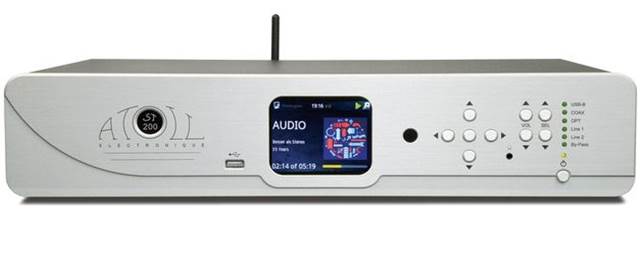
Atoll ST200 front view
The ST200 is the more expensive of two streamers in the range; the less expensive ST100 has a more plain facia and lower spec parts, but is functionally the same. Unlike the touch sensitive glass panel of the Cyrus Lyric reviewed this month, the ST200 sticks with conventional buttons on its front panel, which give tactile assurance that something has been done, and the TFT screen will confirm it’s the right thing. The 90mm (3.5”) display is larger than average, and Atoll uses this to show information next to album art when it’s working as a network streamer, or input name or volume level when it is not. It is also a high-grade DAC in its own right, with a BurrBrown PCM1792 chipset and inputs in all the popular flavours; there are USB A sockets front and rear for Apple devices or USB sticks. The USB B receiver is a Class 1 Audio type, which means sample rates are limited to 96kHz, but this does mean that you don’t need a driver to be installed in the partnering computer. Whether anyone ever connects their computer to a network streamer is the real question; networked audio with its easy app control will always be far more ergonomic than using a connected computer, and in this case can deliver higher bit rates.
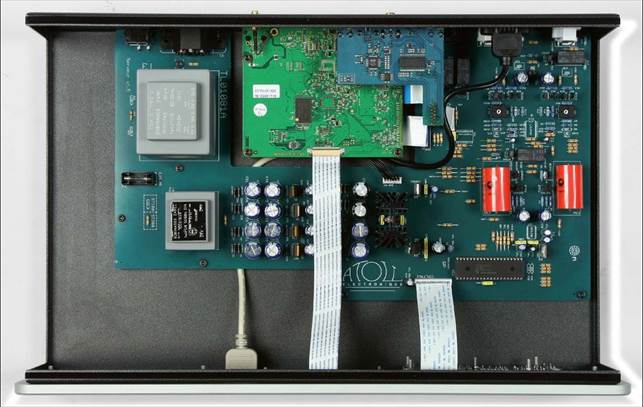
Inside Atoll ST200
The ST200 is also an internet radio, using the vTuner service. This has plenty of stations, but the option to load presets does not appear to be on the downloadable app, but is instead on the handset. The app also stores a list of recent stations, which works in a similar fashion so long as you don’t do too much station hopping. I found the interface for radio a little glitchy when used on an iPhone, but got used to it quite quickly. It puts the BBC at the top of a list of UK stations, which makes it quick and easy to find either live feeds or previous shows. Where things get odd is in the labelling of on-demand material, because that changes every week, but you soon get the hang of it.
The ST200 also has volume controlled output via RCA phono sockets. This can be bypassed if you have a preamplifier; all you have to do is press the bypass button for a few seconds. However, the array of inputs, digital and one analogue, mean this streamer/DAC is sufficiently equipped for preamp duties in many systems. The volume control is analogue despite its digital display and the output stage is Class A. It also has digital outputs for a DAC upgrade and a 3.5mm headphone jack.
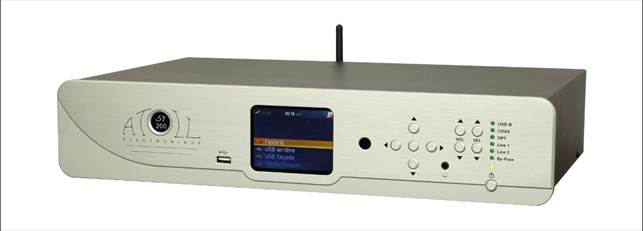
Atoll ST200 rear view
The ST200 can be run in a wired or wireless network, with the former requiring no passwords to get up and running, because you are essentially choosing a server. This is considerably easier with the free iOS 6 or Android app than with handset and front panel, but this is always the way with streamers. The Android app proved a little unstable on my less than spectacular Samsung smartphone, the iOS version being much steadier on a vintage iPhone. It’s not as well sorted as some apps, but you can persuade it to do most of what’s needed without resorting to medieval torture. It would be useful to have quicker access to the input change mode rather than a zone key on every page, but this is a minor niggle in what is generally a serviceable interface.
The Atoll is a great sounding streamer with a natural, even-handed balance that delivers well scaled and involving music. It pulls out lots of character from whatever is played and gives the emotional side of a performance free rein. Melanie de Biasio is not one to hold back on the feelings, but she does it in a controlled fashion that lends her greater power. On the Atoll, it was possible to hear the way that reverb was used in the recording but not so much as to undermine the atmosphere that it lends to the material on her album No Deal [Play It Again Sam].
More important is the Atoll’s timing ability; this is what reels you in and makes you want to listen. It’s the equal to the Cyrus Lyric in this regard, but the Atoll has a rounder tonal balance and a textured, detailed midrange than the Cyrus’ line output, which is a little bright by comparison. The Atoll delves deep into the quiet parts of the recording and scoops out low level notes and sounds, elements that give the music more depth and substance when added to the whole. Leonard Cohen’s voice on ‘The Jungle Line’ [River: The Joni Letters, Verve] has real presence and sounds deep and rich next to Herbie Hancock’s piano, itself a solid, dark, rigid, and beautiful instrument that stands four square in the room. This fine result was achieved with the aid of an ATC P1 power amplifier, Townshend cables, and PMC fact.8 loudspeakers.
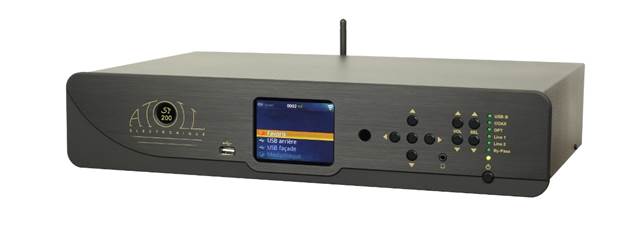
Atoll ST200 black edition
The result was so strong that I decided to see how close it was to the Naim NDS I use as a reference, a comparison that showed the Atoll in a positive light. It’s not as well focussed or real, and timing is weaker than the Naim, but the difference was not as great as you might expect given the extra cost involved. The Atoll is more expansive in imaging terms, which is quite an appealing quality even if it’s not quite as accurate.
Feeding the digital signal from the NDS into the Atoll’s coax input produces a fine result as well. Again, it’s tonally natural, but the timing qualities of the source are obvious and there’s a tension between musicians on certain tracks that’s quite uncanny. It’s extremely coherent and very engaging as a result; the Benjamin Taubkin album (reviewed in the music section) really hangs together well and, even though it’s a largeish ensemble, there’s a strong sense of interplay between the musicians. Big Brother and the Holding company, on the other hand, sounds excessively compressed by comparison; the latter is patently not a good transfer, but the openness of the Taubkin makes matters worse.

Atoll ST200 back view
I also hooked up my Macbook to the USB input and used Audirvana Plus to spin a few tunes. This revealed the strange absence of 88.2kHz as an accepted sampling frequency, but also revealed that the timing qualities heard with other sources remained with this one. This time Weather Report’s ‘Birdland’ [Heavy Weather, Columbia] provided the cues and proved once again that if you had Jaco Pastorius in your band it was hard to go wrong (that only happened with his solo albums!). This was a DSD version played over PCM (DoP) and while it always seems a bit small it sounds excellent. More complex material was not quite so successful, however, and it wasn’t long before I reverted to the ST200’s main suit, network streaming. This played the same track in a considerably more cohesive and convincing manner. It also revealed that server quality is paramount with such set ups, the CAD CAT delivering a distinctly superior result to the alternatives I had on hand.
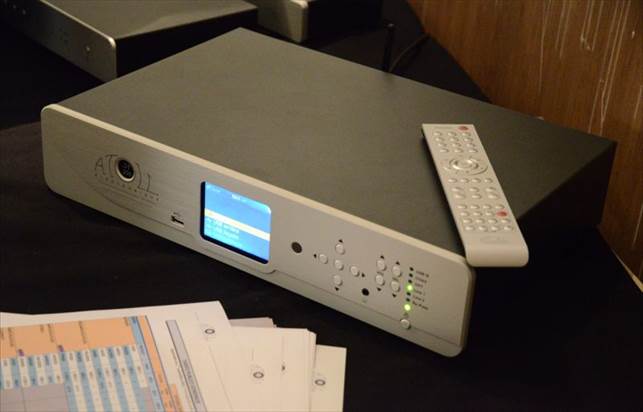
Atoll ST200 and remote
At this stage I gave the net radio a spin and was surprised to find that the Atoll doesn’t switch over to this source of its own accord, if an auxiliary input had previously been in operation. It works well with the low bit rates of online stations; FIP from France is very listenable at 128kbps not least because the programming is so strong, and Radio 3’s Late Junction worked remarkably well considering it was coming through at only 48kbps. One glitch with the app here is that the Late Junction shows it lists are incorrectly dated and differently dated depending on where you read them. This is because the available shows change from week to week, but so long as you realise that the app is always displaying the last three broadcast shows then this is not an issue.
I have to say that this streamer has marked an auspicious start for Atoll chez Kennedy. It manages to turn digital files into remarkably undigital sounding music thanks to a decent streaming engine and a pretty respectable DAC. This combined with what seems a very reasonable price puts it into contention with the better variants on the streaming theme. The app interface is not the slickest around, but with a bit of familiarisation you can get it to do what you want without too much effort. I suspect it would be even better on a tablet. So not merely a ring shaped coral reef, but a French contender in the affordable high end stakes, Atoll would seem to be a name to remember.
